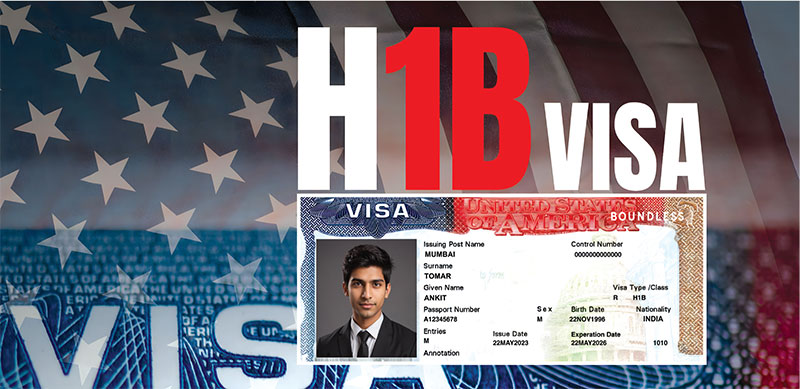Blitz Bureau
NEW DELHI: Panic, confusion and then a hasty White House climb-down – it was a weekend of whiplash for hundreds of thousands of Indians on H-1B visas last week.
On September 19, US President Donald Trump stunned the tech world by announcing an up to 50-fold hike in the cost of skilled worker permits – to $100,000. Chaos followed: Silicon Valley firms urged staff not to travel outside the country, overseas workers scrambled for flights, and immigration lawyers worked overtime to decode the order.
By next day, the White House sought to calm the storm, clarifying that the fee applied only to new applicants and was a one-off. Yet, the long-standing H-1B programme – criticised for undercutting American workers but praised for attracting global talent – still faces an uncertain future.
US raises one-time fee for H-1B visa to $100,000, from $5000 earlier; Indian professionals to be impacted most
Even with the tweak, the policy effectively shutters the H-1B pipeline that, for three decades, powered the American dream for millions of Indians and, more importantly, supplied the lifeblood of talent to US industries.
That pipeline reshaped both countries. For India, the H-1B became a vehicle of aspiration: small-town coders turned dollar earners, families vaulted into the middle class, and entire industries – from airlines to real estate – catered to a new class of globe-trotting Indians.
For the US, it meant an infusion of talent that filled labs, classrooms, hospitals and start-ups. Today, Indian-origin executives run Google, Microsoft and IBM, and Indian doctors make up nearly 6 per cent of the US physician workforce.
Indians dominate the H-1B programme, making up more than 70 per cent of the recipients in recent years. China was the second-largest source, making up about 12 per cent of beneficiaries.
Even if it is a one-time payment, a rise in the H-1B visa fee by the US will have a multifaceted impact on the Indian economy, affecting everything from the IT sector to individual households.
The H-1B visa is a non-immigrant visa that allows US employers to temporarily employ foreign workers in specialty occupations, and a significant portion of these visas are granted to Indian professionals, particularly in the technology industry.
Impact on Indian IT sector
The primary and most immediate impact of the hike will be on the IT sector. Giants like Tata Consultancy Services (TCS), Infosys, and Wipro are among the largest users of H-1B visas.
A fee hike directly increases their operational costs for deploying employees to the US. This can eat into their profit margins and make them less competitive against US-based firms or firms from other countries.
The Indian IT sector has already been reducing its reliance on these visas, with filings dropping by over 50 per cent in recent years, signalling a shift towards stronger offshore and near-shore delivery models. However, a significant fee hike still presents a challenge.
Impact on remittances
The effects of a fee hike also trickle down to individual Indian professionals and their families. Many highly skilled Indian workers view the H-1B visa as a gateway to better career opportunities and a higher standard of living.
A fee increase can make the process more expensive for individuals, especially those who may be sponsored by smaller companies or who are applying for the visa independently. The financial burden can be a deterrent for some, leading them to explore opportunities in other countries like Canada or Australia, which have more immigrant-friendly policies.
The ripple effect on the Indian economy is also visible in the form of reduced remittances. Remittances from the US are a crucial source of foreign exchange for India.
A higher H-1B fee could reduce the number of Indian professionals working in the US, thereby impacting the amount of money sent back home. This, in turn, can affect the disposable income of families in India and the country’s overall foreign exchange reserves.
Historically, H-1B visa fees have been a combination of several different fees, which varied depending on the company and the type of application. Before the recent change, the total cost for an H-1B visa petition ranged from approximately $2,000 to $5,000.
A typical H-1B visa fee includes following costs:-
* Registration fee: A fee for registering for the visa
* Base petition fee: A fee for filing Form I-129, the Petition for a Non-immigrant Worker.
* Fraud prevention and detection fee: A fee to help prevent and detect fraud related to H-1B visas.
* American Competitiveness and Workforce Improvement Act of 1998 fee: An additional fee for certain employers.
* Public Law 114-113 fee: An additional fee for companies with 50 or more employees, where more than 50 per cent are on H-1B or L-1 visas.
* Premium processing fee: An optional fee for expedited processing of the application.
While initially the fee hike may seem like a negative, it could accelerate a “reverse brain drain.” If the H-1B process becomes too costly or restrictive, more Indian professionals might choose to stay in India or return after a few years abroad. This could strengthen the domestic talent pool and spur innovation within India itself.
It could also prompt Indian IT firms to pivot from a traditional “body shopping” or service-based model to a more product-driven one. Instead of simply providing manpower for on-site projects in the US, they might invest more in developing their own products and intellectual property from India. This could be a long-term positive for the Indian tech ecosystem, fostering the growth of home-grown ventures and research labs.



